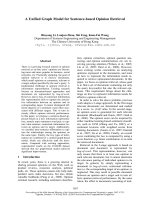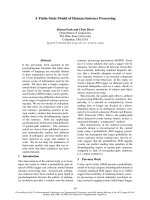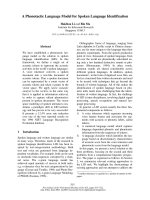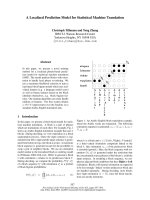Báo cáo khoa học: "A Web-based Evaluation Framework for Spatial Instruction-Giving Systems" docx
Bạn đang xem bản rút gọn của tài liệu. Xem và tải ngay bản đầy đủ của tài liệu tại đây (1.19 MB, 6 trang )
Proceedings of the 50th Annual Meeting of the Association for Computational Linguistics, pages 49–54,
Jeju, Republic of Korea, 8-14 July 2012.
c
2012 Association for Computational Linguistics
A Web-based Evaluation Framework for Spatial Instruction-Giving Systems
Srinivasan Janarthanam, Oliver Lemon, and Xingkun Liu
Interaction Lab
School of Mathematical and Computer Sciences
Heriot Watt University, Edinburgh
sc445,o.lemon,
Abstract
We demonstrate a web-based environment for
development and testing of different pedes-
trian route instruction-giving systems. The
environment contains a City Model, a TTS
interface, a game-world, and a user GUI in-
cluding a simulated street-view. We describe
the environment and components, the metrics
that can be used for the evaluation of pedes-
trian route instruction-giving systems, and the
shared challenge which is being organised us-
ing this environment.
1 Introduction
Generating navigation instructions in the real world
for pedestrians is an interesting research problem
for researchers in both computational linguistics
and geo-informatics (Dale et al., 2003; Richter and
Duckham, 2008). These systems generate verbal
route directions for users to go from A to B, and
techniques range from giving ‘a priori’ route direc-
tions (i.e. all route information in a single turn) and
incremental ‘in-situ’ instructions, to full interactive
dialogue systems (see section 4). One of the major
problems in developing such systems is in evaluat-
ing them with real users in the real world. Such eval-
uations are expensive, time consuming and painstak-
ing to organise, and are carried out not just at the end
of the project but also during the development cycle.
Consequently, there is a need for a common platform
to effectively compare the performances of verbal
navigation systems developed by different teams us-
ing a variety of techniques (e.g. a priori vs. in-situ
or rule-based vs. machine learning).
This demonstration system brings together exist-
ing online data resources and software toolkits to
create a low-cost framework for evaluation of pedes-
trian route instruction systems. We have built a
web-based environment containing a simulated real
world in which users can simulate walking on the
streets of real cities whilst interacting with differ-
ent navigation systems. This evaluation framework
will be used in the near future to evaluate a series of
instruction-giving dialogue systems.
2 Related work
The GIVE challenge developed a 3D virtual in-
door environment for development and evaluation
of indoor pedestrian navigation instruction systems
(Koller et al., 2007; Byron et al., 2007). In this
framework, users can walk through a building with
rooms and corridors, similar to a first-person shooter
game. The user is instructed by a navigation sys-
tem that generates route instructions. The basic idea
was to have several such navigation systems hosted
on the GIVE server and evaluate them in the same
game worlds, with a number of users over the in-
ternet. Conceptually our work is very similar to the
GIVE framework, but its objective is to evaluate sys-
tems that instruct pedestrian users in the real world.
The GIVE framework has been successfully used for
comparative evaluation of several systems generat-
ing instructions in virtual indoor environments.
Another system, “Virtual Navigator”, is a simu-
lated 3D environment that simulates the real world
for training blind and visually impaired people to
learn often-used routes and develop basic naviga-
tion skills (McGookin et al., 2010). The framework
49
uses haptic force-feedback and spatialised auditory
feedback to simulate the interaction between users
and the environment they are in. The users simulate
walking by using arrow keys on a keyboard and by
using a device that works as a 3D mouse to simulate
a virtual white cane. Auditory clues are provided
to the cane user to indicate for example the differ-
ence between rush hour and a quiet evening in the
environment. While this simulated environment fo-
cusses on the providing the right kind of tactile and
auditory feedback to its users, we focus on provid-
ing a simulated environment where people can look
at landmarks and navigate based on spatial and vi-
sual instructions provided to them.
User simulation modules are usually developed
to train and test reinforcement learning based in-
teractive spoken dialogue systems (Janarthanam and
Lemon, 2009; Georgila et al., 2006; Schatzmann et
al., 2006). These agents replace real users in interac-
tion with dialogue systems. However, these models
simulate the users’ behaviours in addition to the en-
vironment in which they operate. Users’ dialogue
and physical behaviour are dependent on a number
of factors such as a user’s preferences, goals, knowl-
edge of the environment, environmental constraints,
etc. Simulating a user’s behaviour realistically based
on many such features requires large amounts of
data. In contrast to this approach, we propose a sys-
tem where only the spatial and visual environment is
simulated.
See section 4 for a discussion of different pedes-
trian navigation systems.
3 Architecture
The evaluation framework architecture is shown in
figure 1. The server side consists of a broker module,
navigation system, gameworld server, TTS engine,
and a city model. On the user’s side is a web-based
client that consists of the simulated real-world and
the interaction panel.
3.1 Game-world module
Walking aimlessly in the simulated real world can be
a boring task. Therefore, instead of giving web users
navigation tasks from A to B, we embed navigation
tasks in a game-world overlaid on top of the simu-
lated real world. We developed a “treasure hunting”
game which consists of users solving several pieces
of a puzzle to discover the location of the treasure
chest. In order to solve the puzzle, they interact with
game characters (e.g. a pirate) to obtain clues as to
where the next clue is. This sets the user a number of
navigation tasks to acquire the next clues until they
find the treasure. In order to keep the game interest-
ing, the user’s energy depletes as time goes on and
they therefore have limited time to find the treasure.
Finally, the user’s performance is scored to encour-
age users to return. The game characters and enti-
ties like keys, chests, etc. are laid out on real streets
making it easy to develop a game without develop-
ing a game-world. New game-worlds can be easily
scripted using Javascript, where the location (lati-
tude and longitude) and behaviour of the game char-
acters are defined. The game-world module serves
game-world specifications to the web-based client.
3.2 Broker
The broker module is a web server that connects the
web clients to their corresponding different naviga-
tion systems. This module ensures that the frame-
work works for multiple users. Navigation systems
are instantiated and assigned to new users when they
first connect to the broker. Subsequent messages
from the users will be routed to the assigned navi-
gation system. The broker communicates with the
navigation systems via a communication platform
thereby ensuring that different navigation systems
developed using different languages (such as C++,
Java, Python, etc) are supported.
3.3 Navigation system
The navigation system is the central component of
this architecture, which provides the user instruc-
tions to reach their destinations. Each navigation
system is run as a server remotely. When a user’s
client connects to the server, it instantiates a navi-
gation system object and assigns it to the user ex-
clusively. Every user is identified using a unique id
(UUID), which is used to map the user to his/her re-
spective navigation system. The navigation system
is introduced in the game scenario as a buddy sys-
tem that will help the user in his objective: find the
treasure. The web client sends the user’s location to
the system periodically (every few seconds).
50
Figure 1: Evaluation framework architecture
3.4 TTS engine
Alongside the navigation system we use the Cere-
proc text-to-speech engine that converts the utter-
ances of the system into speech. The URL of the
audio file is then sent to the client’s browser which
then uses the audio plugin to play the synthesized
speech to the user. The TTS engine need not be used
if the output modality of the system is just text.
3.5 City Model
The navigation system is supported by a database
called the City Model. The City Model is a GIS
database containing a variety of data required to sup-
port navigation tasks. It has been derived from an
open-source data source called OpenStreetMaps
1
. It
consists of the following:
• Street network data: the street network data
consists of nodes and ways representing junc-
tions and streets.
• Amenities: such as ATMs, public toilets, etc.
• Landmarks: other structures that can serve as
landmarks. E.g. churches, restaurants, etc.
The amenities and landmarks are represented as
nodes (with latitude and longitude information). The
City Model interface API consists of a number of
1
www.openstreetmaps.org
subroutines to access the required information such
as the nearest amenity, distance or route from A to B,
etc. These subroutines provide the interface between
the navigation systems and the database.
3.6 Web-based client
The web-based client is a JavaScript/HTML pro-
gram running on the user’s web browser software
(e.g. Google Chrome). A snapshot of the webclient
is shown in figure 2. It has two parts: the streetview
panel and the interaction panel.
Streetview panel: the streetview panel presents a
simulated real world visually to the user. When
the page loads, a Google Streetview client (Google
Maps API) is created with an initial user coordinate.
Google Streetview is a web service that renders a
panoramic view of real streets in major cities around
the world. This client allows the web user to get a
panoramic view of the streets around the user’s vir-
tual location. A gameworld received from the server
is overlaid on the simulated real world. The user can
walk around and interact with game characters using
the arrow keys on his keyboard or the mouse. As the
user walks around, his location (stored in the form
of latitude and longitude coordinates) gets updated
locally. Streetview also returns the user’s point of
view (0-360 degrees), which is also stored locally.
Interaction panel: the web-client also includes an
51
interaction panel that lets the user interact with his
buddy navigation system. In addition to user lo-
cation information, users can also interact with the
navigation system using textual utterances or their
equivalents. We provide users with two types of in-
teraction panel: a GUI panel and a text panel. In the
GUI panel, there are GUI objects such as buttons,
drop-down lists, etc. which can be used to construct
requests and responses to the system. By clicking
the buttons, users can send abstract semantic repre-
sentations (dialogue actions) that are equivalent to
their textual utterances. For example, the user can
request a route to a destination by selecting the street
name from a drop down list and click on the Send
button. Similarly, users can click on ‘Yes’, ‘No’,
‘OK’, etc. buttons to respond to the system’s ques-
tions and instructions. In the text panel, on the other
hand, users are free to type any request or response
they want. Of course, both types of inputs are parsed
by the navigation system. We also plan to add an ad-
ditional input channel that can stream user speech to
the navigation system in the future.
4 Candidate Navigation Systems
This framework can be used to evaluate a variety
of navigation systems. Route navigation has been
an interesting research topic for researchers in both
geoinformatics and computational linguistics alike.
Several navigation prototype systems have been de-
veloped over the years. Although there are several
systems that do not use language as a means of com-
munication for navigation tasks (instead using geo-
tagged photographs (Beeharee and Steed, 2006; Hi-
ley et al., 2008), haptics (Bosman et al., 2003), mu-
sic (Holland et al., 2002; Jones et al., 2008), etc), we
focus on systems that generate instructions in natu-
ral language. Therefore, our framework does not in-
clude systems that generate routes on 2D/3D maps
as navigation aids.
Systems that generate text/speech can be further
classified as follows:
• ‘A priori’ systems: these systems generate
route instructions prior to the users touring the
route. These systems describe the entire route
before the user starts navigating. Several web
services exist that generate such lists of step-
by-step instructions (e.g. Google/Bing direc-
tions).
• ‘In-situ’ or incremental route instruction sys-
tems: these systems generate route instructions
incrementally along the route. e.g. CORAL
(Dale et al., 2003). They keep track of the
user’s location and issue the next instruction
when the user reaches the next node on the
planned route. The next instruction tells the
user how to reach the new next node. Some
systems do not keep track of the user, but re-
quire the user to request the next instruction
when they reach the next node.
• Interactive navigation systems: these systems
are both incremental and interactive. e.g.
DeepMap (Malaka and Zipf, 2000). These
systems keep track of the user’s location and
proactively generate instructions based on user
proximity to the next node. In addition, they
can interact with users by asking them ques-
tions about entities in their viewshed. For ex-
ample “Can you see a tower at about 100 feet
away?”. Questions like these will let the system
assess the user’s location and thereby adapt its
instruction to the situated context.
5 Evaluation metrics
Navigation systems can be evaluated using two
kinds of metrics using this framework. Objective
metrics such as time taken by the user to finish
each navigation task and the game, distance trav-
elled, number of wrong turns, etc. can be directly
measured from the environment. Subjective met-
rics based on each user’s ratings of different features
of the system can be obtained through user satisfac-
tion questionnaires. In our framework, users are re-
quested to fill in a questionnaire at the end of the
game. The questionnaire consists of questions about
the game, the buddy, and the user himself, for exam-
ple:
• Was the game engaging?
• Would you play it again (i.e. another similar
gameworld)?
• Did your buddy help you enough?
52
Figure 2: Snapshot of the web client
• Were the buddy instructions easy to under-
stand?
• Were the buddy instructions ever wrong or mis-
placed?
• If you had the chance, will you choose the same
buddy in the next game?
• How well did you know the neighbourhood of
the gameworld before the game?
6 Evaluation scenarios
We aim to evaluate navigation systems under a vari-
ety of scenarios.
• Uncertain GPS: GPS positioning available in
smartphones is erroneous (Zandbergen and
Barbeau, 2011). Therefore, one scenario for
evaluation would be to test how robustly nav-
igation systems handle erroneous GPS signals
from the user’s end.
• Output modalities: the output of navigation
systems can be presented in two modalities:
text and speech. While speech may enable a
hands-free eyes-free navigation, text displayed
on navigation aids like smartphones may in-
crease cognitive load. We therefore believe it
will be interesting to evaluate the systems in
both conditions and compare the results.
• Noise in user speech: for systems that take
as input user speech, it is important to handle
noise in such a channel. Noise due to wind and
traffic is most common in pedestrian scenarios.
Scenarios with different levels of noise settings
can be evaluated.
• Adaptation to users: returning users may have
learned the layout of the game world. An inter-
esting scenario is to examine how navigation
systems adapt to user’s increasing spatial and
visual knowledge.
Errors in GPS positioning of the user and noise
in user speech can be simulated at the server end,
thereby creating a range of challenging scenarios to
evaluate the robustness of the systems.
7 The Shared Challenge
We plan to organise a shared challenge for outdoor
pedestrian route instruction generation, in which a
variety of systems can be evaluated. Participating
research teams will be able to use our interfaces
and modules to develop navigation systems. Each
team will be provided with a development toolkit
53
and documentation to setup the framework in their
local premises for development purposes. Devel-
oped systems will be hosted on our challenge server
and a web based evaluation will be organised in con-
sultation with the research community (Janarthanam
and Lemon, 2011).
8 Demonstration system
At the demonstration, we will present the evaluation
framework along with a demo navigation dialogue
system. The web-based client will run on a laptop
using a high-speed broadband connection. The nav-
igation system and other server modules will run on
a remote server.
Acknowledgments
The research has received funding from the
European Community’s Seventh Framework
Programme (FP7/2007-2013) under grant
agreement no. 216594 (SPACEBOOK project
www.spacebookproject.org).
References
Ashweeni K. Beeharee and Anthony Steed. 2006. A nat-
ural wayfinding exploiting photos in pedestrian navi-
gation systems. In Proceedings of the 8th conference
on Human-computer interaction with mobile devices
and services (2006).
S. Bosman, B. Groenendaal, J. W. Findlater, T. Visser,
M. de Graaf, and Panos Markopoulos. 2003. Gen-
tleGuide: An Exploration of Haptic Output for Indoors
Pedestrian Guidance. In Proceedings of 5th Interna-
tional Symposium, Mobile HCI 2003, Udine, Italy.
D. Byron, A. Koller, J. Oberlander, L. Stoia, and
K. Striegnitz. 2007. Generating Instructions in Vir-
tual Environments (GIVE): A challenge and evaluation
testbed for NLG. In Proceedings of the Workshop on
Shared Tasks and Comparative Evaluation in Natural
Language Generation.
Robert Dale, Sabine Geldof, and Jean-Philippe Prost.
2003. CORAL : Using Natural Language Generation
for Navigational Assistance. In Proceedings of the
Twenty-Sixth Australasian Computer Science Confer-
ence (ACSC2003), 4th7th February, Adelaide, South
Australia.
Kallirroi Georgila, James Henderson, and Oliver Lemon.
2006. User simulation for spoken dialogue systems:
Learning and evaluation. In Proceedings of Inter-
speech/ICSLP, pages 1065–1068.
Harlan Hiley, Ramakrishna Vedantham, Gregory Cuel-
lar, Alan Liuy, Natasha Gelfand, Radek Grzeszczuk,
and Gaetano Borriello. 2008. Landmark-based pedes-
trian navigation from collections of geotagged photos.
In Proceedings of the 7th International Conference on
Mobile and Ubiquitous Multimedia (MUM) 2008.
S. Holland, D. Morse, and H. Gedenryd. 2002. Audio-
gps: Spatial audio navigation with a minimal atten-
tion interface. Personal and Ubiquitous Computing,
6(4):253–259.
Srini Janarthanam and Oliver Lemon. 2009. A User Sim-
ulation Model for learning Lexical Alignment Policies
in Spoken Dialogue Systems. In European Workshop
on Natural Language Generation.
Srini Janarthanam and Oliver Lemon. 2011. The
GRUVE Challenge: Generating Routes under Uncer-
tainty in Virtual Environments. In Proceedings of
ENLG / Generation Challenges.
M. Jones, S. Jones, G. Bradley, N. Warren, D. Bainbridge,
and G. Holmes. 2008. Ontrack: Dynamically adapt-
ing music playback to support navigation. Personal
and Ubiquitous Computing, 12(7):513–525.
A. Koller, J. Moore, B. Eugenio, J. Lester, L. Stoia,
D. Byron, J. Oberlander, and K. Striegnitz. 2007.
Shared Task Proposal: Instruction Giving in Virtual
Worlds. In Workshop on Shared Tasks and Compar-
ative Evaluation in Natural Language Generation.
Rainer Malaka and Er Zipf. 2000. Deep Map - chal-
lenging IT research in the framework of a tourist in-
formation system. In Information and Communication
Technologies in Tourism 2000, pages 15–27. Springer.
D. McGookin, R. Cole, and S. Brewster. 2010. Vir-
tual navigator: Developing a simulator for independent
route learning. In Proceedings of Workshop on Haptic
Audio Interaction Design 2010, Denmark.
Kai-Florian Richter and Matt Duckham. 2008. Simplest
instructions: Finding easy-to-describe routes for navi-
gation. In Proceedings of the 5th international confer-
ence on Geographic Information Science.
Jost Schatzmann, Karl Weilhammer, Matt Stuttle, and
Steve Young. 2006. A survey of statistical user sim-
ulation techniques for reinforcement-learning of dia-
logue management strategies. The Knowledge Engi-
neering Review, 21:97–126.
P. A. Zandbergen and S. J. Barbeau. 2011. Positional
accuracy of assisted gps data from high-sensitivity
gps-enabled mobile phones. Journal of Navigation,
64(3):381–399.
54









